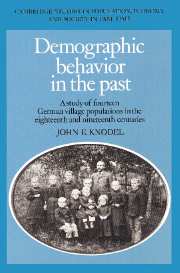 Demographic Behavior in the Past
Demographic Behavior in the Past Published online by Cambridge University Press: 04 August 2010
The histories of vital events for individual couples are often incomplete and unusable for demographic analysis since the village genealogies include any family (or individual person if he or she cannot be linked to a family unit) that has at least one event entered in the local registers. By coding only couples for whom at least some prespecified minimum amount of information is available, substantial savings in time and effort can be effected at the data preparation stage. For the present study, 6 of the 14 village genealogies in the sample were coded completely (Braunsen, Kappel, Massenhausen, Middels, Öschelbronn, and Rust), while only preselected couples were coded for the remainder. In addition, a more detailed coding scheme was used for the villages in which all couples were coded. In the present study, for the large majority of purposes only those families from the fully-coded villages are included which meet the same minimum tests of completeness that were applied to the villages for which couples were preselected. Thus for most practical purposes the same selection of cases was involved for all 14 villages in the sample.
Criteria for initial selection
Given the considerable attention focused on reproductive behavior in this study, the criteria for selection were chosen such that most couples for whom there was insufficient information to permit their use for fertility analyses were excluded.
To save this book to your Kindle, first ensure [email protected] is added to your Approved Personal Document E-mail List under your Personal Document Settings on the Manage Your Content and Devices page of your Amazon account. Then enter the ‘name’ part of your Kindle email address below. Find out more about saving to your Kindle.
Note you can select to save to either the @free.kindle.com or @kindle.com variations. ‘@free.kindle.com’ emails are free but can only be saved to your device when it is connected to wi-fi. ‘@kindle.com’ emails can be delivered even when you are not connected to wi-fi, but note that service fees apply.
Find out more about the Kindle Personal Document Service.
To save content items to your account, please confirm that you agree to abide by our usage policies. If this is the first time you use this feature, you will be asked to authorise Cambridge Core to connect with your account. Find out more about saving content to Dropbox.
To save content items to your account, please confirm that you agree to abide by our usage policies. If this is the first time you use this feature, you will be asked to authorise Cambridge Core to connect with your account. Find out more about saving content to Google Drive.